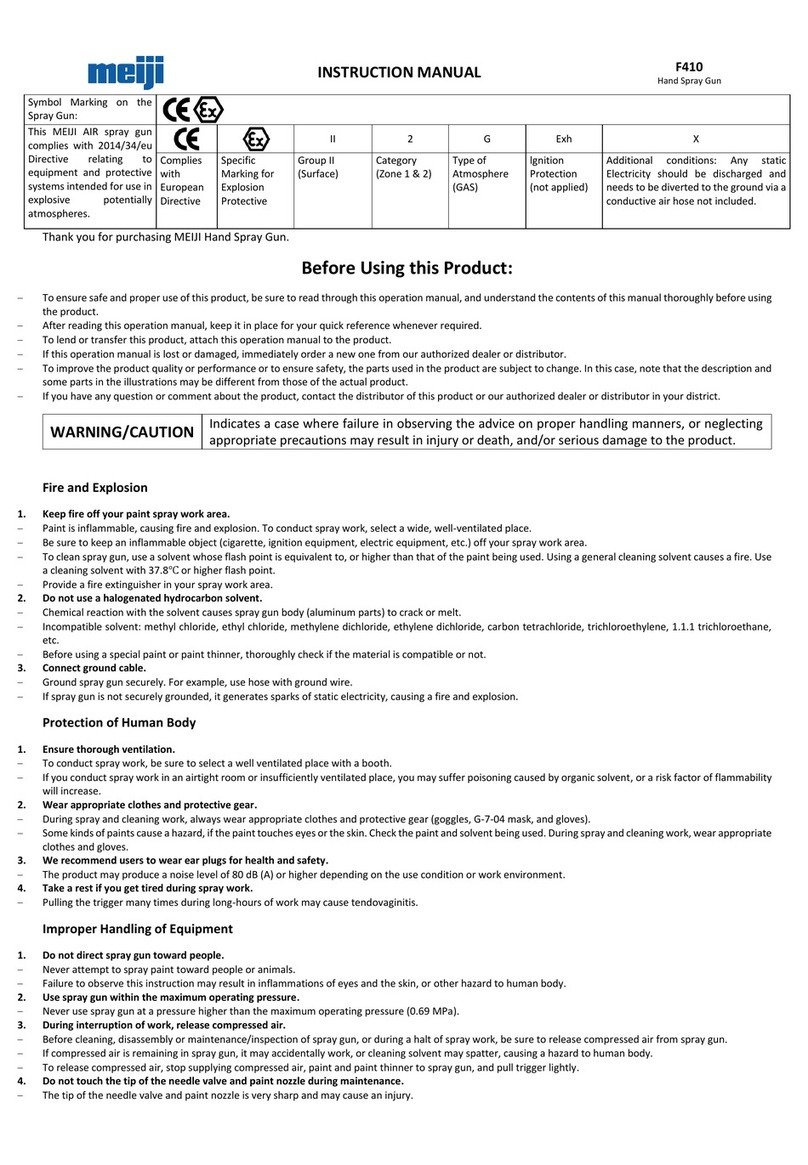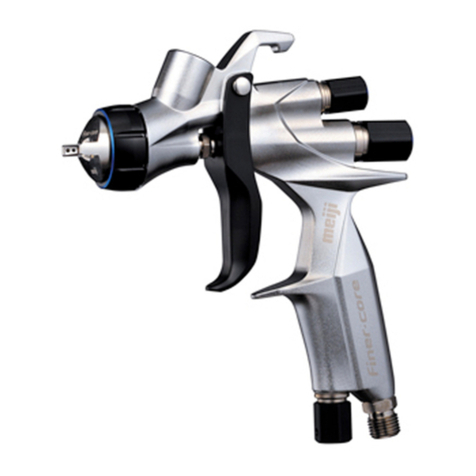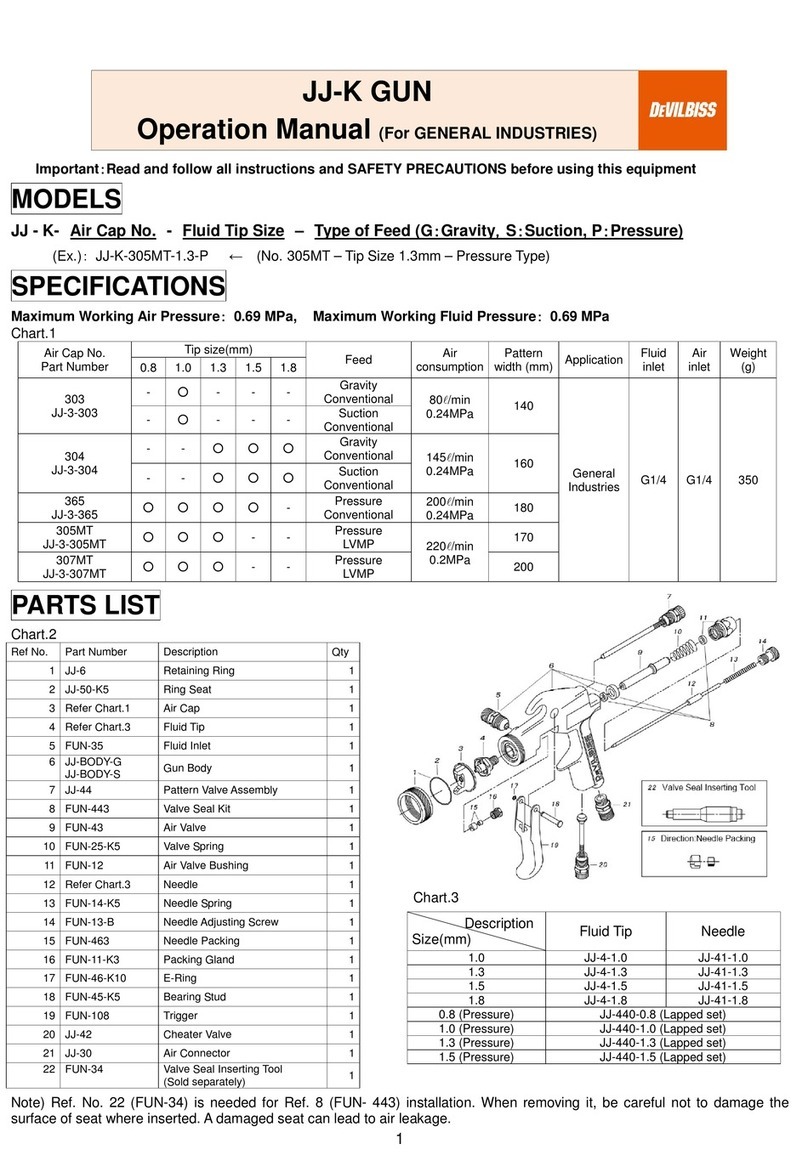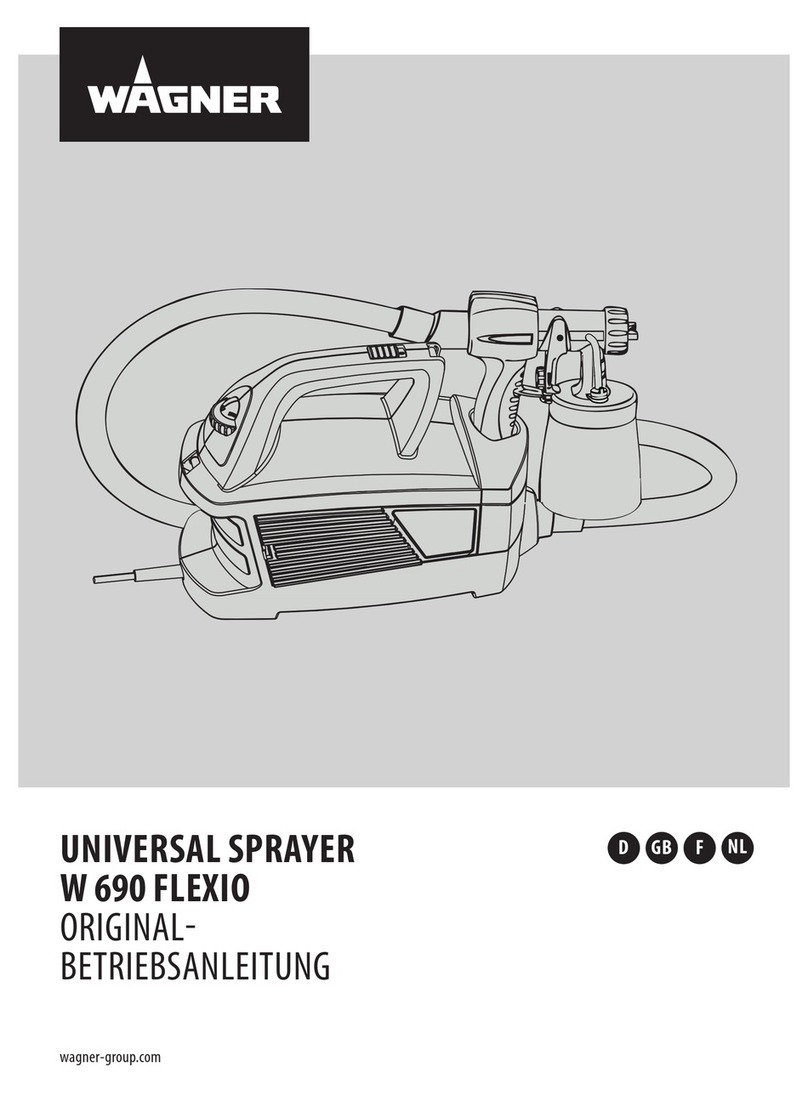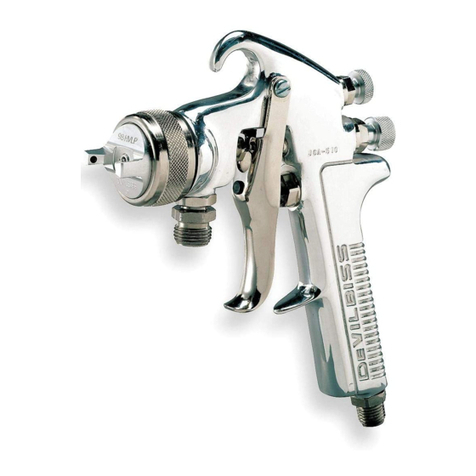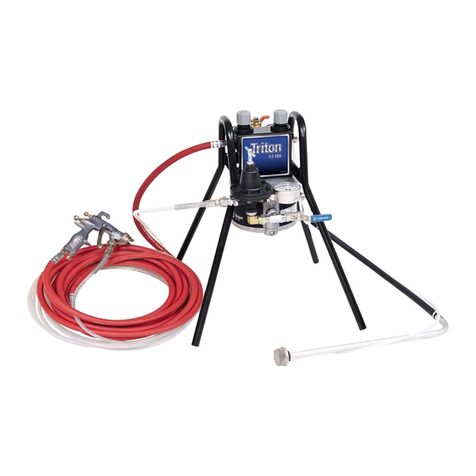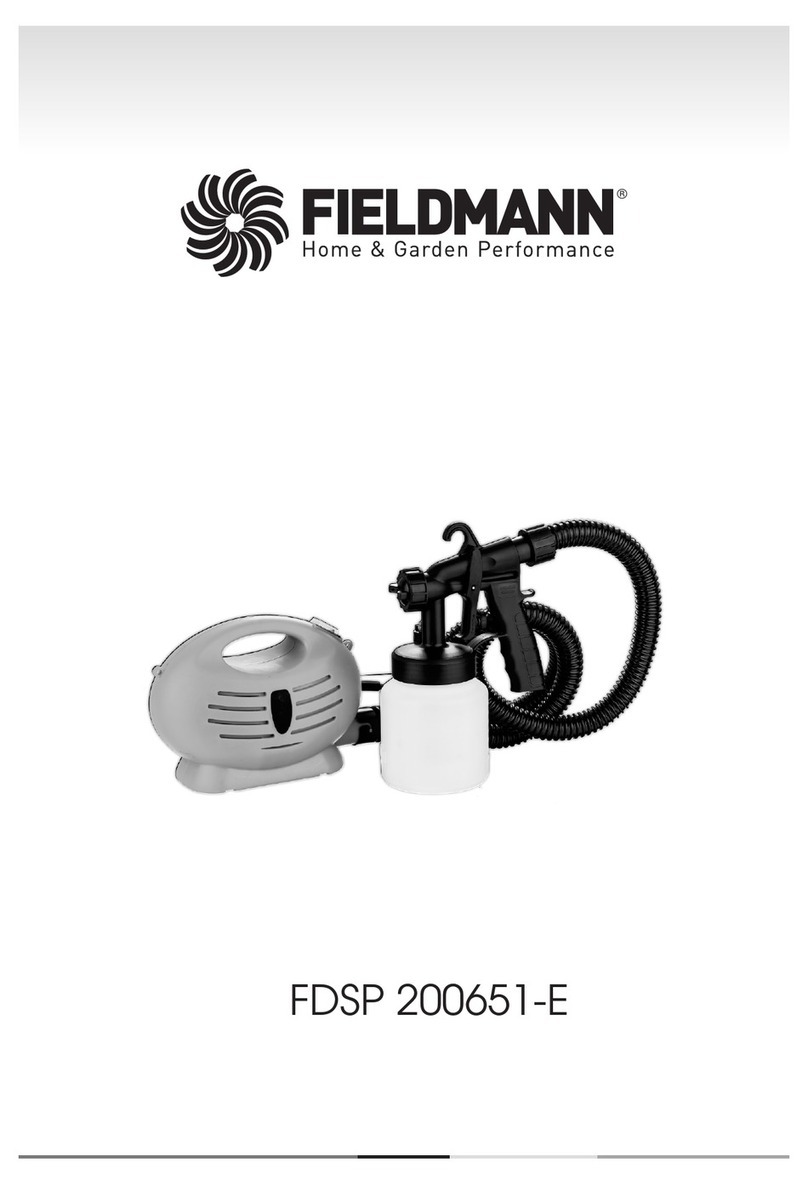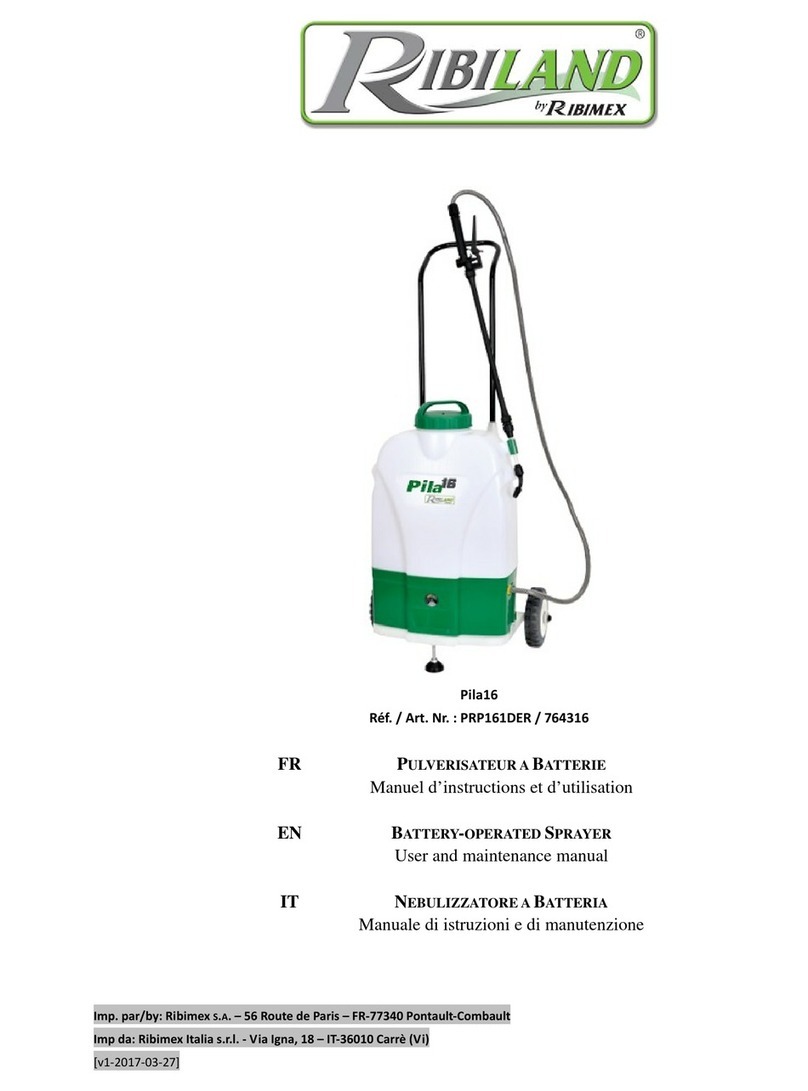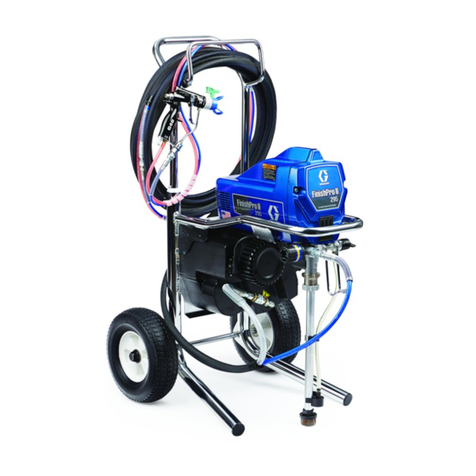Meiji FINER-CORE-13 User manual

Ⅱ2GExhX
000
Symbol Marking on the Spray Gun:
This MEIJI AIR spray gun
complies with 2014/34/eu Directive
relating to equipment and protective
systems intended for use in
explosive potentially atmospheres.
Ⅱ2 G Exh X
Complies
with
European
Directive
Specific
Marking for
Explosion
Protective
Group Ⅱ
(Surface)
Category
(Zone 1&2)
Type of
Atmosphere
(GAS)
lgnition
Protection
(not applied)
Additional conditions:
Any static Electricity
should be discharged
and needs to be
diverted to the ground
via a conductive air
hose not included.
Thank you for purchasing MEIJI Hand Spray Gun.
Before Using this Product
■To ensure safe and proper use of this product, be sure to read through this operation manual, and understand the contents of this manual thoroughly before using the product.
■After reading this operation manual, keep it in place for your quick reference whenever required.
■To lend or transfer this product, attach this operation manual to the product.
■If this operation manual is lost or damaged, immediately order a new one from our authorized dealer or distributor.
■To improve the product quality or performance or to ensure safety, the parts used in the product are subject to change. In this case, note that the description and some parts in
the illustrations may be different from those of the actual product.
■If you have any question or comment about the product, contact the distributor of this product or our authorized dealer or distributor in your district.
WARNING/CAUTION Indicates a case where failure in observing the advice on proper handling manners,
or neglecting appropriate precautions may result in injury or death, and/or serious
dama
g
e to the product.
Fire and Explosion
1. Keep fire off your paint spray work area.
Paint is inflammable, causing fire and explosion. To conduct spray work, select a wide, well-ventilated place.
Be sure to keep an inflammable object (cigarette, ignition equipment, electric equipment, etc.) off your spray work area.
To clean spray gun, use a solvent whose flash point is equivalent to, or higher than that of the paint being used. Using a general cleaning
solvent may cause a fire. Use a cleaning solvent with 37.8°C or higher flash point.
Provide a fire extinguisher in your spray work area.
2. Do not use a halogenated hydrocarbon solvent.
Chemical reaction with the solvent causes spray gun body (aluminum parts) to crack or melt.
Incompatible solvent: methyl chloride, ethyl chloride, methylene dichloride, ethylene dichloride, carbon tetrachloride, trichloroethylene, 1.1.1
trichloroethane, etc.
Before using a special paint or paint thinner, thoroughly check if the material is compatible or not.
3. Connect ground cable.
Ground spray gun securely. For example, use a hose with ground wire.
If spray gun is not securely grounded, it may generate sparks of static electricity, causing a fire and explosion.
Protection of Human Body
1. Ensure thorough ventilation.
To conduct spray work, be sure to select a well ventilated place with a booth.
If you conduct spray work in an airtight room or insufficiently ventilated place, you may suffer poisoning caused by organic solvent, or a risk
factor of flammability will increase.
2. Wear appropriate clothes and protective gear.
During spray and cleaning work, always wear appropriate clothes and protective gear (goggles, G-7-04 masks, and gloves).
Some kinds of paint cause a hazard if the paint touches eyes or skin. Check the paint and solvent being used. During spray and cleaning
work, wear appropriate clothes and gloves.
3. We recommend users to wear ear plugs for health and safety.
The product may produce a noise level of 80 dB (A) or higher depending on the use condition or work environment.
4. Take a rest if you get tired during spray work.
Pulling the trigger many times during long-hours of work may cause tendovaginitis.
Improper Handing of Equipment
1. Do not direct spray gun toward people.
Never attempt to spray paint toward people or animals.
Failure to observe this instruction may result in inflammations of eyes and skin, or other hazard to human body.
2. Use spray gun within the maximum operating pressure.
Never use spray gun at a pressure higher than the maximum operating pressure (0.69 MPa).
3. During interruption of work, release compressed air.
Before cleaning, disassembly or maintenance/inspection of spray gun, or during a halt of spray work, be sure to release compressed air from
spray gun
If compressed air is remaining in spray gun, it may accidentally work, or cleaning solvent may spatter, causing a hazard to human body.
To release compressed air from spray gun, stop supplying compressed air, paint, or paint thinner to spray gun, and pull the trigger lightly.
4. Do not touch the tip of the needle valve and paint nozzle during maintenance.
The tip of the needle valve and paint nozzle is very sharp and may cause an injury.
-1-
2. Maintenance and Inspection
1. Clean and lubricate spray gun everyday to maintain it in the best operating condition
2. Wipe dust off the spray gun body with a cloth damped with a solvent.
If spray gun is soaked in a solvent, lubricant is removed, and an adhering substance enters air circuit, causing a trouble in spray work.
We shall not be liable for any problems resulting from the use of a gun cleaner that causes dust or paint waste to enter the air
circuit of paint nozzle or air cap.
3. After using spray gun, be sure to clean it with a clean solvent, and leave the cup empty.
4. To clean cup, remove surplus paint from cup first, and then pour an appropriate solvent into cup to wash off residual paint completely.
5. If spray gun is used with a cleaning solvent remaining in the gun and cup, and with paint waste or dust adhering to paint circuit, it causes a
failure in spray work.
6. After disassembling air cap (3) and paint nozzle (2), soak them in a solvent, and clean them with a brush. When disassembling air cap (3) and
paint nozzle (2), be careful not to damage them.
7. To clean paint circuit, spray a small quantity of solvent as in the same manner as spray work.
8. Be sure not to damage each hole of air cap (3), and the center hole and tip periphery of paint nozzle (2).
9. If needle valve ass'y (6) or air valve (26) malfunctions, apply a small quantity of oil (non-silicone oil) to the sliding part from the outside.
10. After cleaning the equipment with water, be sure to eliminate water. Residual water causes the equipment to rust away.
11. Soaking whole spray gun in solvent may cause spray gun malfunction. Also soaking air cap ass’y. itself for extended period may cause a
defective spray pattern.
3. Specifications
Model
Paint
feed
system
Paint nozzle
bore
mm
Applicable air cap
Spraying
distance
mm
Spraying air
pressure
(Cap internal
pressure)
MPa
Air
consumption
L/min
Paint spraying
volume
mL/min
Maximum
effective
pattern
mm
Connection
diameter
Weight
g
FINER-CORE-13
Gravity
1.3 FINER-CORE
200
0.20 300 170 280
G1/4 (Air)
G3/8 (Paint) 340
FINER-CORE-15 1.5 200 300
FINER-CORE-HVLP-13 1.3 FINER-CORE-HVLP 0.18
(0.07) 380 135 280
FINER-CORE-HVLP-15 1.5 155 300
* The paint viscosity values are equivalent to 20 seconds for the lacquer enamel paint using Meiji V-1 viscosity cup.
4. Parts List
-3-
Other Precaution
1. Do not modify the product.
Do not modify spray gun.
If you modify spray gun, it cannot provide sufficient performance. Also, a failure of the machine may result.
2. Stop other equipment.
To conduct spray work in an operating area of other equipment (robot, reciprocating equipment, etc.), confirm that the equipment has stopped
first.
If you touch a robot or reciprocating equipment, you may get injury.
3. Do not use spray gun for food and chemicals.
Do not apply spray gun to food or chemicals.
Corrosion of paint circuit may result in an accident. Also, mixture of foreign substances may result in health disorder.
4. If an abnormal condition occurs, immediately stop spray gun.
If you find a problem, immediately stop spray gun, and examine the cause of the problem. Do not use gun until the problem can be solv
Installation
1. Use clean compressed air.
Use clean compressed air that has passed through an air dryer or air filter. If contaminated air is used, it results in a failure in spray work.
2. Ensure tight connections.
When connecting a paint cup or an air hose to spray gun, tighten them securely by using a spanner. If the connection is loose, compressed air,
paint and other liquids may spatter over human body, painted work pieces and peripheral equipment, resulting in damage.
3. Conform to the rated withstand pressure of a hose.
Make sure that air pressure supplied to an air hose does not exceed the rated withstand pressure of hose. Do not use an old or a
damaged hose.
1. Operating Procedure
1. Mount a paint cup and air hose securely to the spray gun by using a spanner or other tool.
2. Although it varies depending on the paint viscosity, property, and operating conditions, a recommended spraying pressure is between 0.15 to
0.25 MPa.
Never use spray gun at a pressure higher than the maximum operating pressure (0.69 MPa).
3. Recommended spraying distance is 150 to 250 mm. If spray gun is too close to a target work piece or it swings like an arc, good finished
quality cannot be obtained.
4. To obtain a uniformly finished condition, always hold spray gun at a right angle to the spraying surface.
5. Tightening the air volume adjusting screw clockwise will decrease the air volume, and loosening the air volume adjusting screw
counterclockwise will increase the air volume.
6. If you tighten the pattern adjusting screw by turning it clockwise completely, paint is sprayed in a spot pattern. As you loosen the pattern
adjusting screw by turning it counterclockwise, spray pattern area gradually increases.
When you rotate the screw approximately three times, the pattern area becomes the maximum. Adjust the spray pattern depending on the
spray work step and the type of paint being used.
7. If you tighten the paint adjusting screw by turning it clockwise, spray volume decreases. As you loosen the screw by turning it
counterclockwise, spray volume gradually increases. When you rotate the screw three to four times, spray volume becomes the maximum.
Set paint volume depending on spray work conditions.
-2-
5. Parts Replacement
Before replacing spray gun parts, remove residual paint, and clean spray gun. Then, release air pressure from spray gun, and remove the air hose
and paint cup.
To repair spray gun, place it in a clean level place, and wear protective goggles. For parts replacement, use the specified appropriate tools.
Replacement of paint nozzle and needle valve ass’y (It is recommended that these parts should be simultaneously replaced.)
1. Remove paint adjusting screw (35) and needle spring (9), and pull out needle valve ass'y (6) from the spray gun body.
2. Remove air cap set (3).
3. Remove paint nozzle (2) by using a spanner 17 or socket wrench 17.
4. Tighten paint nozzle (2) at a tightening torque of 10 N・m by using a torque wrench.
Replacement of air volume adjusting valve ass'y and pattern adjusting valve ass'y
1. Before assembling or disassembling air volume adjusting valve ass'y (16) and pattern adjusting valve ass'y (17), turn the knob
counterclockwise completely to loosen it.
Replacement of valve seat, air valve, valve spring, O-ring presser, and needle cylinder
1. Remove paint adjusting screw (35) and needle spring (9), and pull out needle valve ass'y (6) from the spray gun body.
2. Remove needle cylinder (34) using spanner 14.
3. Remove O-ring presser (29), valve spring (27), and air valve (26) from the spray gun body.
4. Remove valve seat (30) by using hexagon wrench 10, so that seat surface on the mounting part will not be damaged.
5. Tighten valve seat (30) by using hexagon wrench 10 until the seat touches the spray gun body. Then, re-tighten the seat lightly.
6. Insert air valve (26) until it reaches the innermost end so as not to damage seat surface. Then, insert valve spring (27) and O-ring presser (29).
7. Tighten needle cylinder (34) using spanner 14.
Replacement of packing presser spring, O-ring presser, packing guide, and O-ring S10 perfluor
1. Following the procedure for “Replacement of valve seat, air valve, valve spring, O-ring presser, and needle cylinder”, remove the relevant parts.
2. Remove packing presser spring (25), O-ring presser (29), packing guide (28), and O-ring S10 (31).
3. If packing guide (28) and O-ring S10 (31) are hard to remove, vibrate spray gun.
4. Insert O-ring S10 (31), packing guide (28), O-ring presser (29), and packing presser spring (25) in this order.
Replacement of sleeve
1. Remove needle packing screw (23) with spanner 10.
2. Remove sleeve (24).
3. Insert sleeve (24).
4. Tighten needle packing screw (23) with spanner 10.
6. Troubleshooting
Trouble condition Cause Corrective action
Paint breaking Lack of paint in the paint cup
The paint circuit is clogged.
A screw of the paint circuit connecting part, or paint nozzle (2), is loose, or the tapered
seat is damaged.
Sleeve (24) has been worn out, or the needle packing screw (23) is loose.
Refill paint.
Clean the air circuit with a solvent.
Tightening or replacement
Replace sleeve (24) or re-tighten needle packing
screw (23) securely.
One-sided
pattern
Part of the square hole of air cap (3) has been clogged or damaged.
Paint or dust is adhering to the tip periphery of paint nozzle (2).
Cleaning or replacement
Cleaning or replacement
Crescent
pattern
Part of the square hole of air cap (3) has been clogged or damaged,
or paint or dust is adhering to inside of the center hole, or the center hole has been
damaged.
Paint or dust is adhering to the tip periphery of paint nozzle (2).
Cleaning or replacement
Cleaning or replacement
Thick in middle Paint nozzle (2) has been worn out, and nozzle bore diameter increased.
Spraying air pressure is too low.
Paint viscosity is too high.
Replacement
Increase spraying air volume and pressure.
Reduce paint viscosity.
Narrow in middle Spraying air pressure is too high.
Dust or paint is adhering to the gap between the center hole of air cap (3) and the
periphery of paint nozzle (2).
Reduce spraying air volume and pressure.
Cleaning
Paint leak from the needle
packing screw
Needle packing screw (23) is loose.
Sleeve (24) has been worn out.
Adjust needle packing screw (23).
Replacement
Paint leak from the tip of the
paint nozzle
Paint nozzle (2) or needle valve ass'y (6) has been worn out or damaged.
Sleeve (24) or needle valve ass'y (6) is stuck.
Improper adjustment of needle packing screw (23)
Replacement
Lubrication
Adjustment
2020/07/14E2020/07/14
Head Office 3-14, 2-chome, Tagawa, Yodogawa-ku Osaka 532-0027, Japan
Tel:+81-6-6309-1227 Fax:+81-6-6309-0157
MEIJI AIR COMPRESSOR MFG. CO., LTD.
-4-
No. Name Quantity
1 Body 1
2 Paint nozzle 1
3 Air cap set 1
6 Needle valve ass'y 1
9 Needle spring 1
10 Spring insert 1
11 Trigger 1
12 Trigger pin 1
13 Trigger screw 1
16 Air volume adjusting valve ass'y 1
17 Pattern adjusting valve ass'y 1
20 U-packing P5 2
22 Trigger presser 1
23 Needle packing screw 1
24 Sleeve 1
25 Packing presser spring 1
26 Air valve 1
27 Valve spring 1
28 Packing guide 1
29 O-ring presser 2
30 Valve seat 1
31 O-ring S10 1
32 Hexagon nipple 1/4×M11 1
34 Needle cylinder 1
35 Paint adjusting screw 1
36 Paint adjusting screw cover 1
37 Adjusting screw cover 2
38 Hexagon socket set screw 3
39 Head base (with parallel pin) 1
Instruction Manual FINER-CORE
Hand Spray Gun
Pattern adjusting screw
Paint adjusting screw
Clockwise
(
S
p
ot
p
attern
)
Counterclockwise
Air volume
adjusting screw
Counterclock
wise Clockwise
Rotation direction of
paint adjusting screw
Rotation direction of
pattern adjusting screw
Max. Min.
(Flat pattern)

Residual Risks
A residual risk map of necessary protection measures by machine users
(Short title: Residual risk map)
Product type: "Spray Gun: FINER-CORE/FINER-CORE-HVLP"
Date of entry: July 14, 2020
MEIJI AIR COMPRESSOR MFG. CO., LTD.
*Make sure to read and understand the user manual carefully before using the product. This document is intended as a
reference to the user manual. Accordingly, do not use the products based only on your understanding of the content of this
document.
The residual risks are classified and described as defined below.
Danger Indicates content which, if no protection measures are taken, will likely result in death or serious injury
Warning Indicates content which, if no protection measures are taken, will possibly result in death or serious injury
Caution Indicates content which, if no protection measures are taken, will likely result in death or minor injury
The symbols and numbers of locations shown in the figure correspond to those in the "list of residual risks" of this product. For
details of each residual risk, please refer to the "list of residual risks."
-1-
Residual risks for non-specified machine parts
Danger
Warning No.3, No.5, No.6, No.7, No.8, No.9
Caution
Point D
Danger
Warning
Caution No.11
Point A
Danger
Warning No.1, No.10
Caution
Point C
Danger
Warning No.4
Caution
Point B
Danger
Warning No.2
Caution

Residual Risks
A residual risk map of necessary protection measures by machine users
(Short title: List of residual risks)
Product type: "Spray Gun: FINER-CORE/FINER-CORE-HVLP"
Date of entry: July 14, 2020
MEIJI AIR COMPRESSOR MFG. CO., LTD.
*Make sure to read and understand the user manual carefully before using the product. This document is intended as a
reference to the user manual. Accordingly, do not use the products based only on your understanding of the content of this
document.
The "risk level" is classified and described as defined below.
Danger Indicates content which, if no protection measures are taken, will likely result in death or serious injury
Warning Indicates content which, if no protection measures are taken, will possibly result in death or serious injury
Caution Indicates content which, if no protection measures are taken, will likely result in death or minor injury
*2 The symbols and numbers shown as "location in the machine" are the machine part numbers in the "residual risk map" of this product. Refer to the
"residual risk map" for specific locations on the machine.
2020/07/14 E2020/07/14
-2-
No. Operational
stage Work
Qualificatio
n/training
required for
work
Location in
the machine
*2
Risk level
*1 Risk details
Protection measures
taken by machine
users
Page
No. in
the
user
manual
1 Use
Preparing for
work
Work in
progress
- A Warning
Paint spurting out from
unexpected locations and
splashing over users as a
result of incorrect
connections between the
air joint and the paint joint
Wear protection P1~2
2 Use All - B Warning Ignition that leads to fire
caused by static electricity
Check the use of a
ground wire hose and its
installation
P1~2
3 Use/
maintenance
Work in
progress/disa
ssembling
and cleaning
- Not specified Warning
Organic solvents, etc.
splash over people's eyes
and skin and cause
inflammation
Wear protection P1~2
4 Use Work in
progress - C Warning
Tenosynovitis caused by
the repeated action of
pulling a trigger
Take proper breaks P1~2
5 Use All - Not specified Warning Ignition from sparks or
electrical equipment, etc.,
leading to a blaze.
Strictly prohibit the use of
fire P1~2
6 Use
Preparing for
work
Work in
progress
- Not specified Warning
Paint, etc. spurts out from
unexpected locations and
splashes over users or gets
in their eyes due to
operating beyond the
specified pressure, causing
injuries or blindness
Wear protection P1~2
7 Use/
maintenance
Preparing for
work
Work in
progress
- Not specified Warning
Unexpected failures or
accidents caused by
modification of the product
or using non-genuine parts
Do not modify the
product
Use genuine parts
P1~2
8 Use
Preparing for
work
Work in
progress
- Not specified Warning
Hearing impairment caused
by staying at a location for a
long time where noise is
generated, such as where
air is being blown, etc.
Use of earplugs
recommended P1~2
9
Use/
maintenance
Work in
progress/disa
ssembling
and cleaning
- Not specified Warning
Intoxication caused by
inhaling mist from organic
solvents or paints
Use protection
Work in a paint booth,
etc.
P1~2
10
Use/
maintenance
Preparing for
work
Work in
progress
- A Warning
Injuries caused by spurting
of paint, cleaning fluid, or
air, etc. when a user
attempts to remove a hose
while it is under pressure
Wear protection
Remove the residual
pressure
P1~2
11 Use Preparing for
work - D Caution Puncture wounds caused
by sharp parts such as
needle valves, etc.
Wear protection P1~2
This manual suits for next models
3
Other Meiji Paint Sprayer manuals
Popular Paint Sprayer manuals by other brands
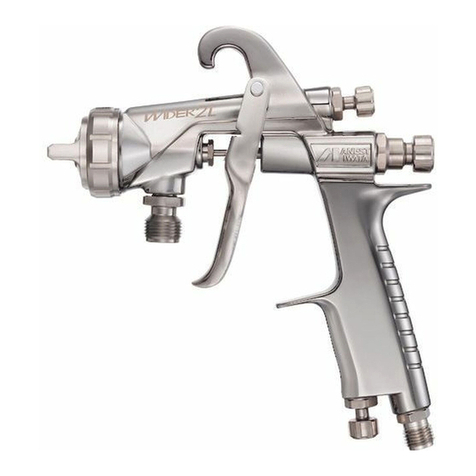
Anest Iwata
Anest Iwata WIDER2L-10G2P instruction manual

Task Force Tips
Task Force Tips G-Force Series INSTRUCTIONS FOR SAFE OPERATION AND MAINTENANCE
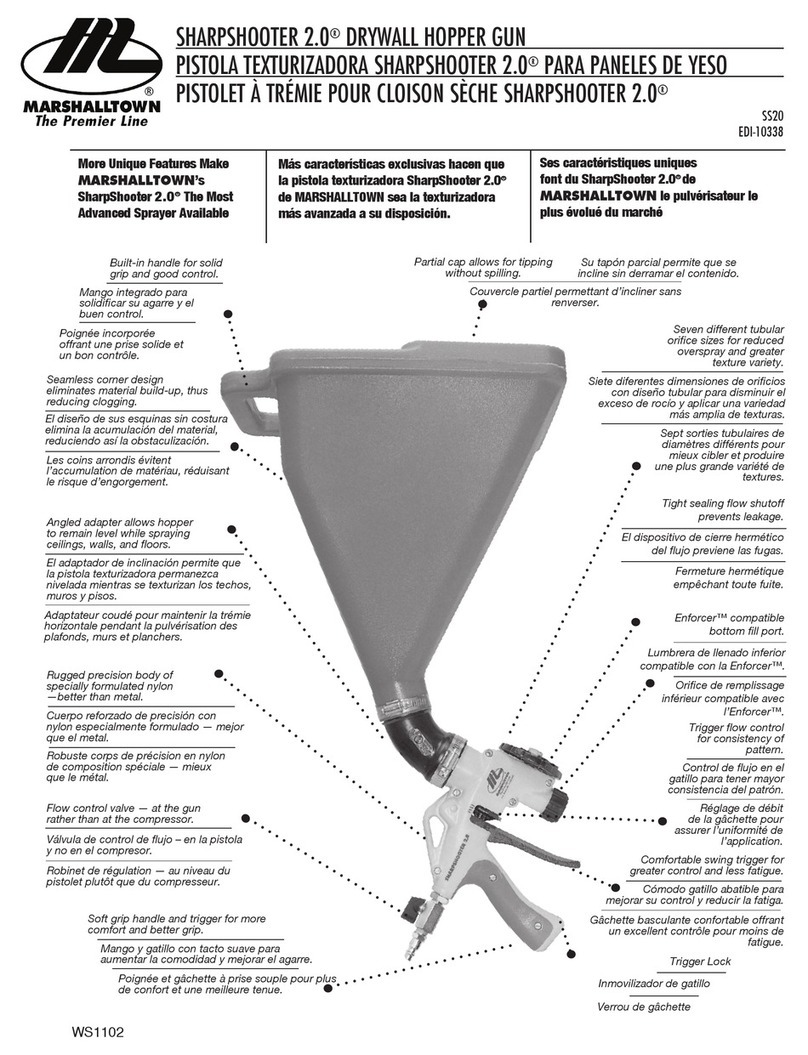
Marshalltown
Marshalltown SS20 SharpShooter 2.0 operating instructions

Jacto
Jacto J600 Operator's manual
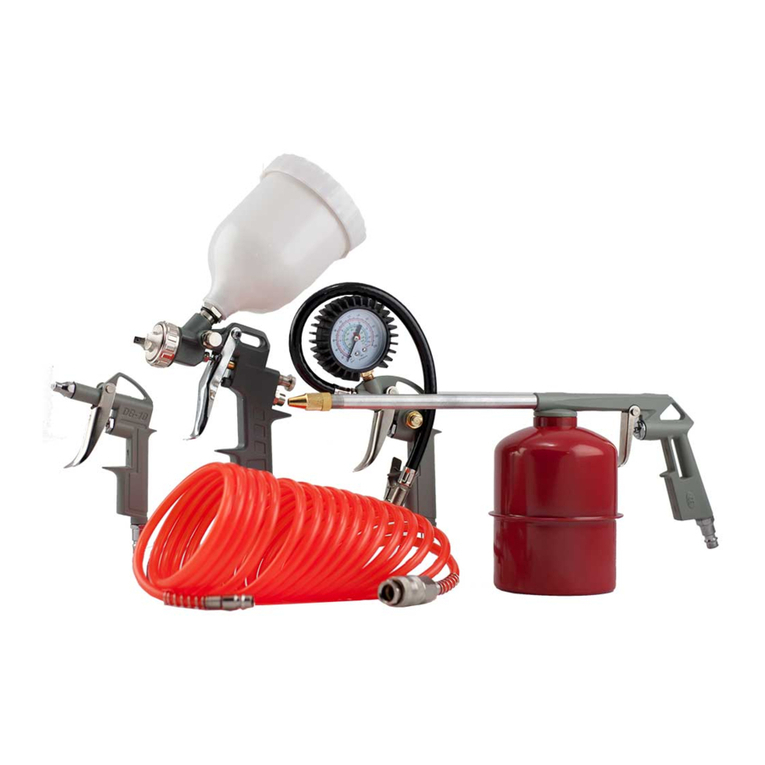
BorMann
BorMann BEA5000 manual
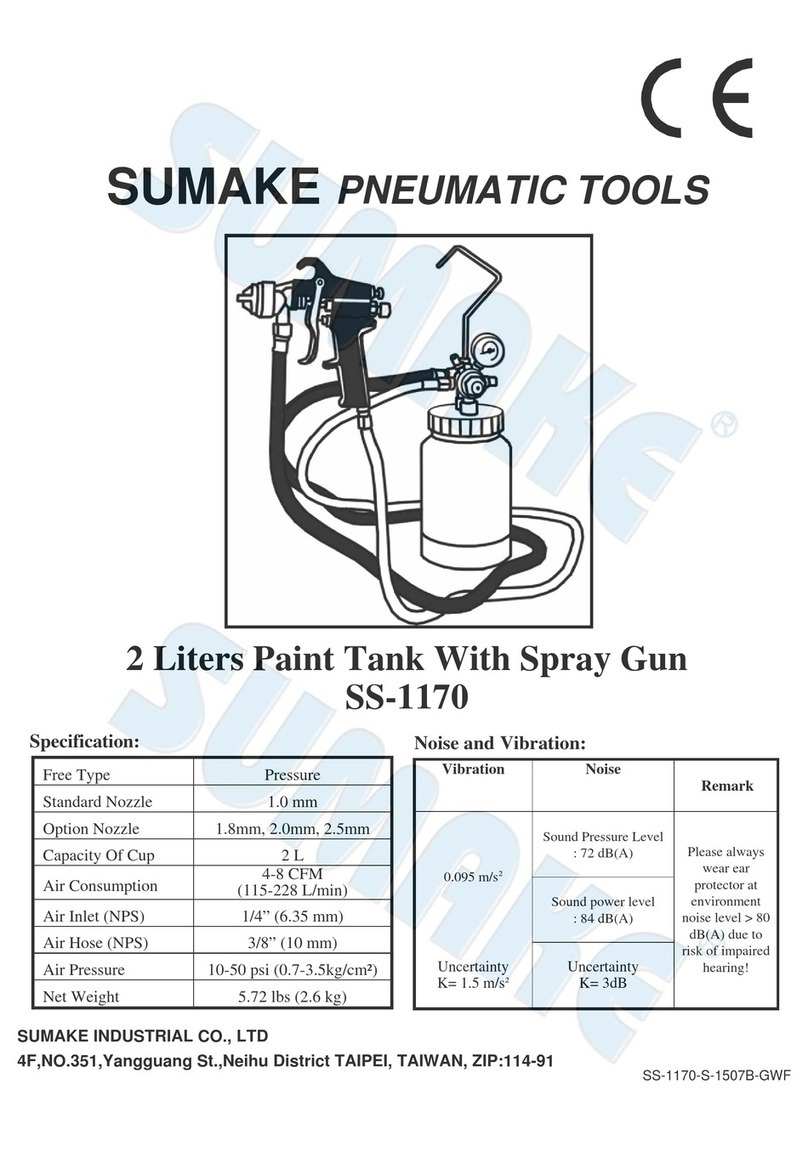
Sumake
Sumake SS-1170 manual
